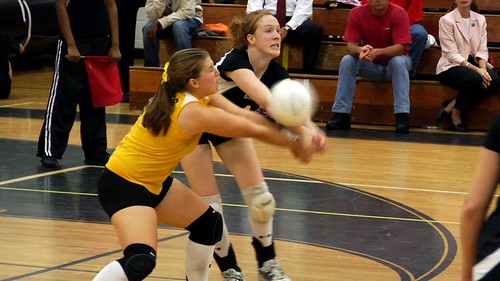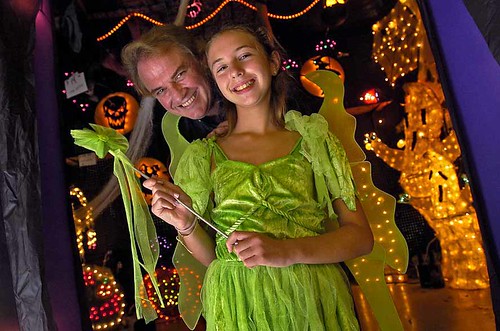
You know how hard it is to shoot volleyball with a video camera?
Not that hard.
Do you know how hard it is shooting video of volleyball in order to try getting a still frame?
Really hard.
Why? One BIG reason: The lack of proper lighting inside high school gyms. Your most important tool is light, and if you have something properly lit, it only depends on your skill and the right moment to get a good shot. Take that vital tool from your box, and you're bound to struggle.
My latest challenge was shooting HD video of a sporting event to get some still images for daily use. The game started at 5:30, and I only had 8 minutes of high def footage to shoot, since I'm still using the 2-4 gig P2 cards. So there's no way to shoot constantly; I had to shoot small clips, depending on my instinct to get some nice shots.
But, the light. Oh, the light. Direct overhead lights yielded only 1/120th second at f/ 1.7, and I had cranked up some gain to 6 decibles. A recipe for disaster? Only if you are clueless with how to use your equipment. But I sure pushed my luck, in any case. I had thought for cranking gain up to (I think it's) 12 db, but I figured that one frame per 30 fps would work. The problem is that you're shooting people who are moving all over the place. So many of what might have made good still shots with a 35mm camera couldn't work with a camcorder shooting at such a slow shutter speed.
I moved all about, shooting different angles, hoping I could find the right spot to capture some footage. Near the end of the shoot is when you wind up finding the "sweet spot," which was behind the last player sitting on the bench, aiming back at the net. I only saw the spot as I turned to watch the action after giving up, and I saw faces of players from both sides, trying to dink the ball on each other's side. Doh! I had less than 1 minute of space remaining, and less than an hour before my next shoot, so I pulled the plug and figured that I should have one image.
The editors back at the office had other plans: "We need one for color and one inside," Steve said, and I opened Quicktime and Final Cut Pro to check each file for a couple good shots. Fortunately, Photoshop and Final Cut are back in working order. There was no squeezing of images, like a couple weeks ago, and I didn't figure out what was done to remedy the situation. All I know is that the widescreen pasting was back.
I found nice "jubo" (the cool way of saying, "celebration," or "jubilation") but didn't have any deejay (my own term for dejection, but no one understands it) and a couple good frames that I copied and pasted onto the Photoshop file. All shot in 1920x1080.... but my camera shot the footage without the digital interlacing, and I was surprised to see no jaggies. I think my camera was set at 30p, and it helped me as well.
This weekend, we're shooting the Ravens at home against the Carolina Panthers, but I won't be able to shoot video, since they've banned those contraptions on-field at game time.
Here's also a shot of a coach. The size that Photoshop suggests for the original size of the Quicktime image is 1920x1080 @ 72dpi. I saved this at 200dpi, and it can be seen here, I hope in its original size. I optimized the size for web use, however. Just peruse the set in Flickr, with shots saved at 72dpi and 200dpi so you can see what they look like, opened in full size.
I also wanted to add some information about floor bounce lighting with the Nikon D2H (you can do this with any camera with a flash you can aim at the floor), from a shoot I did this day as well.
Take a lookie at the image of Dad and daughter, taken with my D2H at this Halloween shop on York Road in Timonium (made me excited about having fun this holiday, too!):

I simply used one flash, the SB-800, but even an undedicated flash will do, like a Vivitar 285. I simply turned the camera upside down so that the flash head will point onto the floor! If the head of yours can move about, just aim the puppy straight down at the ground, but make certain that the color of the floor is white or grey, or close to it. Otherwise you may get some weird color changes.... but don't scare from shooting anyway if you have an orange floor; that may yield some interesting colors as well! Since you're shooting digital, simply make color adjustments as you test the balance of the colors against whatever is in your subject field.
Notice, the lights behind the pair are the standard incandescent (tungsten) lights. If you're so particular that you want true white balance with all things, well, place a warming filter over the flash that will make the output similar to a tungsten light, and change your white balance on the camera to tungsten (the little lightbulb). I like the warmth behind the people, so I kept my flash output daylight balanced, while shooting with the overcast setting on the camera.
Bang out a frame of the light source to make sure that the lights don't over-expose in the frame. They should remain very saturated (another reason I stuck with the warm lamp glow, since a darkened light bulb won't show saturation, but grey if it's white-balanced). The image was shot at 1/60th @ f 4, so I switched the flash output to 1/8th power, since it would stay consistent. Using TTL or auto settings tend to give light outputs that are inconsistent, and with a dark background, I didn't want to waste time. Aiming the flash head slightly behind will keep the top of the flash from throwing any direct light onto the subjects, which make the lighting on their faces quite harsh. If your flash head can't rotate and turn backwards, grab a piece of cardboard and some rubber bands or something to hold it on your flash head and leave it pointing straight down.
If you and your subjects have time, play with the direction and zoom function on the flash head, so you can remember what settings please you (and your subject). I like my zoom feature placed about 50mm to 85mm, but you may like the wider setting. To me, the zoom will allow for more directional yet soft lighting.
No comments:
Post a Comment